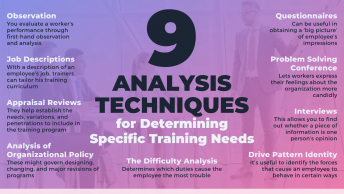The person who can make hard things easy is the trainer.
Training needs analysis is the first step in the training process, and then we start setting learning objectives whereby we answer the following critical questions :
1. What must the training achieve?
2. How will the trainees be affected ( i.e., improved )?
In order to design an effective training programme, we have to translate performance deficiencies into training needs. If you know that salespersons do not sell well, and you have discovered that this deficiency is due to lack of product knowledge, then your learning objectives must address this issue
Why Write Learning Objectives? —— Five valid reasons:
1. Objectives give you a clear direction for training activities. As a trainer, you know where you are going an how will you reach there. Your time on designing a training programme is properly utilized.
2. Objectives give direction to other co-trainers who focus on the same direction. Consequently, they bring about uniformity in the training programme.
3. Learning objectives also motivate trainees to grow as they clearly see WIIFM (what’s in it for me ) that keeps them interested, involved and motivated.
4. Objectives serve as a yardstick and standards to evaluate training. At the end of the programme, participants give you their feedback on the character of the training: how many of learning objectives have been achieved, met or exceeded expectations ? —- This kind of feedback reflects the professionalism of your training, and provides trainees with input which they can use to further enhance their development.
5. Objectives also help sell the training programme to the management as well as trainees who would like to see the payoff for what they do. Objectives shown them the WIIFM for the training time and money they will invest.
Types of Objectives:
Training addresses 3 crucial areas: A S K- Attitude, Skills and Knowledge. Logically, learning objectives should be designed to meet needs in any of these 3 categories.
• Objectives for Skills are fairly easy to evaluate because the action is often the application of the same skills for which you impart training
• For Knowledge-related objectives, trainees should demonstrate that they know something
• Objectives addressing Attitude are challenging to frame. You must think how trainees will demonstrate the desired behaviours
– How would you know if trainees hold a particular attitude? Only through what they say or do.
Sometimes, attitude change cannot be truly measured in a learning situation and field follow-up must occur to determine if the objective has been achieved or not. For example ‘ At the end of this training programme, without a trainer’s participation, each trainee will agree unanimously on the superiority of positive mental attitude’.
Essential Elements:
Learning objectives must always contain these four essential factors :
1. An ACTION to be performed by the trainee
For you to know that a learning objective has been achieved, you should see or hear something which shows that trainees are now able to do something which they could do not perform before training. For this to happen, trainees must perform an action that allows them to demonstrate what they have learnt in the training.
2. CONDITIONS under which the trainee is to perform an action
– Will it be in the classroom or in the field?
– From memory or with an open book?
– With or without working tools and visual aids?
3. CRITERIA for achievement of learning objectives
This identifies how well trainees should perform to be successful.
– Do they have to get all the answers correct, or will 85% be OK?
– Must the action be performed in 5 or 10minutes?
– What is the performance standard, and to what extent trainees should meet this standard?
4. TIMING: Learning objectives must be time-bound
– By when the trainees will have achieved the learning objective ?
In most cases, the timing is ‘ at the end of this training programme, trainees will be able to ……’
Sample Objectives:
Performance Salespersons are unable to convert product’s features Deficiency into customer’s benefits
Learning
1. At the end of this programme, without resources and Objectives given 10 minutes, each trainee will identify at least 10 benefits of the product (Objective: Knowledge)
2. At the end of this training programme, using selling material and visual aids, all the trainees will make an individual presentation of products in terms of the buyer’s benefits (Objective: seeks to improve the Knowledge)











